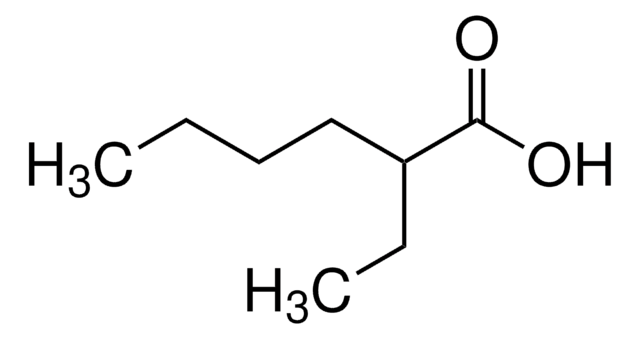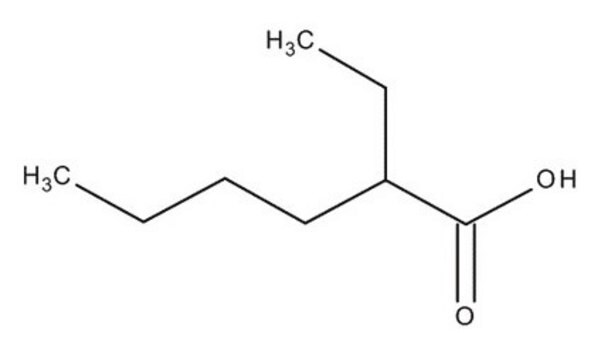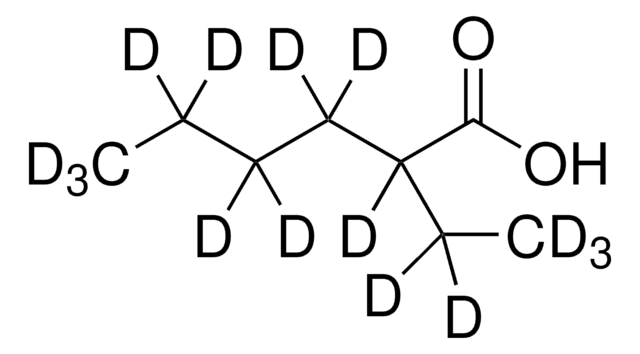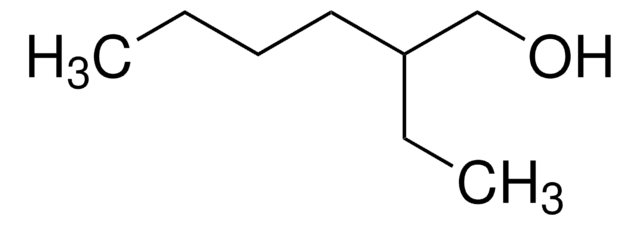538701
Acide 2-éthylhexanoïque
≥99%
Synonyme(s) :
2-Ethylcaproic acid
About This Item
Produits recommandés
Densité de vapeur
4.98 (vs air)
Niveau de qualité
Pression de vapeur
<0.01 mmHg ( 20 °C)
10 mmHg ( 115 °C)
Essai
≥99%
Température d'inflammation spontanée
699 °F
Limite d'explosivité
1.04 %, 135 °F
8.64 %, 188 °F
Indice de réfraction
n20/D 1.425 (lit.)
pb
228 °C (lit.)
Densité
0.903 g/mL at 25 °C (lit.)
Groupe fonctionnel
carboxylic acid
Chaîne SMILES
CCCCC(CC)C(O)=O
InChI
1S/C8H16O2/c1-3-5-6-7(4-2)8(9)10/h7H,3-6H2,1-2H3,(H,9,10)
Clé InChI
OBETXYAYXDNJHR-UHFFFAOYSA-N
Vous recherchez des produits similaires ? Visite Guide de comparaison des produits
Catégories apparentées
Description générale
It has various industrial applications, such as:
- coolant in automotives
- synthetic lubricant
- wetting agent
- co-solvent
- drying of paints
- defoaming agent in pesticides
Application
- A review of the environmental fate and aquatic effects of a series of C4 and C8 oxo-process chemicals.: This review assesses the environmental impact of C4 and C8 oxo-process chemicals, including 2-Ethylhexanoic acid, detailing their degradation, persistence, and effects on aquatic ecosystems (Staples, 2001).
Mention d'avertissement
Danger
Mentions de danger
Conseils de prudence
Classification des risques
Repr. 1B
Code de la classe de stockage
6.1C - Combustible acute toxic Cat.3 / toxic compounds or compounds which causing chronic effects
Classe de danger pour l'eau (WGK)
WGK 1
Point d'éclair (°F)
237.2 °F - closed cup
Point d'éclair (°C)
114 °C - closed cup
Équipement de protection individuelle
Eyeshields, Faceshields, Gloves, type ABEK (EN14387) respirator filter
Faites votre choix parmi les versions les plus récentes :
Déjà en possession de ce produit ?
Retrouvez la documentation relative aux produits que vous avez récemment achetés dans la Bibliothèque de documents.
Les clients ont également consulté
Protocoles
In this study, SPME was used for the analysis of free fatty acids in Parmesan cheese using a 65 μm Carbowax/divinylbenzene (DVB) SPME fiber. Headspace extraction of the cheese sample was conducted at 65 °C for 15 minutes and analyzed by GC with FID detection. SPME is ideal for analyzing the volatiles associated with solid food samples. The phase chemistry of the Nukol GC column provides excellent peak shape of acidic compounds.
Global Trade Item Number
| Référence | GTIN |
|---|---|
| 538701-5ML | |
| 538701-100ML | 4061832566481 |
| 538701-18L | |
| 538701-1L | 4061832566498 |
| 538701-20L | 4061836692872 |
Notre équipe de scientifiques dispose d'une expérience dans tous les secteurs de la recherche, notamment en sciences de la vie, science des matériaux, synthèse chimique, chromatographie, analyse et dans de nombreux autres domaines..
Contacter notre Service technique










